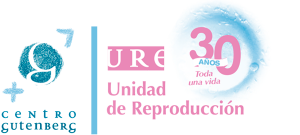Clinical results at URE Centro Gutenberg in 2018: this is how we helped you to get pregnant
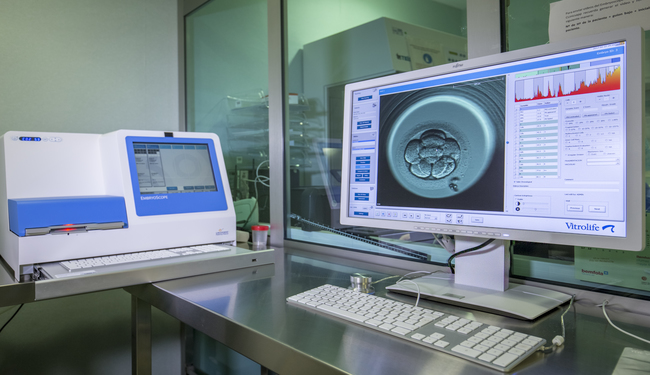
Each year the Department of Health in Spain, with data from the Spanish Fertility Society, publishes the results of all the fertility clinics in Spain that perform assisted reproduction techniques. This data mainly includes results from the two most common techniques in fertility clinics. One is in vitro fertilisation with own eggs, and the other is IVF with egg donation, which in contrast to the first technique requires eggs from a donor.
At our fertility clinic in Spain we contribute to these results every year. We are 100% transparent and for that reason we update our data each year. This means that you can always check out the results we’ve obtained using different assisted reproduction treatments and techniques at our clinic.
In this article we want to summarise our results from 2018. We’ll break down the results by treatment type and we’ll briefly explain what they involve and what these numbers mean.
Two concepts: pregnancy rate per patient and per cycle
Before showing you the clinical results from URE Centro Gutenberg in 2018, there are two concepts we should clarify as they are important when it comes to understanding the percentages we are going to present to you.
First we have what we call the Pregnancy Rate per Patient. This refers to the likelihood of getting pregnant after several attempts with one technique (maximum of 3 attempts). We call these attempts “cycles”.
Then there is the Pregnancy Rate per Cycle. As you can imagine, in this case the percentage refers to the likelihood of getting pregnant after just one individual attempt.
Insemination with partner sperm
Following a mild ovarian stimulation, the male partner’s sperm is processed to obtain the most suitable spermatozoids to inseminate the female.
The pregnancy rate per patient for insemination with partner sperm at our clinic was 26.6% in patients under the age of 38 and 12.5% in women 38 and older.
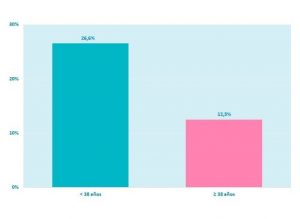
Insemination with donor sperm
In this case, the procedure is exactly the same as with insemination with partner sperm. The only difference is that the sperm is from a donor, meaning that the sample was previously frozen. The sperm selection process is the same.
The likelihood of achieving a pregnancy after a cycle of artificial insemination with donor sperm at URE Centro Gutenberg last year was around 17% (Pregnancy Rate per Cycle).
On the other hand, the success rate of artificial insemination with donor sperm after several consecutive attempts (Pregnancy Rate per Patient) was 33.9% in women under the age of 40 and 10% in women 40 and above.
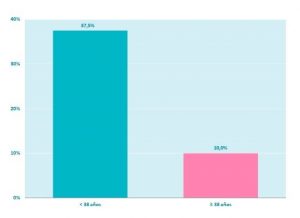
In vitro fertilisation with own eggs
In vitro fertilisation (IVF) involves stimulating the ovaries so that eggs can be retrieved from the female and later put into contact with spermatozoids in the laboratory.
After that, a limited number of embryos will be transferred to the female’s uterus where they will continue developing naturally. On our blog we explain more about IVF and commonly asked questions that generally come up regarding this type of treatment.
In most cycles we obtain more embryos than the ones used for the fresh embryo transfer. When this occurs, the non-transferred embryos are frozen. If we take into consideration the pregnancy rate using fresh embryos and the pregnancy rate with the frozen embryo transfer, we are talking about a cumulative success rate which is how the data is currently presented by the majority of fertility clinics.
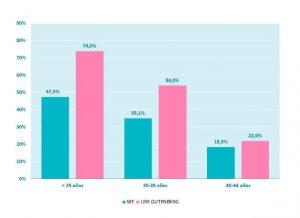
As you can see on the graph above, at our fertility clinic in Spain we have a 74% cumulative success rate from our youngest patients. The success rate drops to 54% for patients between the ages of 35-39 and to 22% for women 40 and above.
As you can see on the graph, the success rates we’ve achieved at URE Centro Gutenberg, especially for younger women, are considerably higher than the reference values established by the Spanish Fertility Society.
In vitro fertilisation with donated eggs (egg donation)
Egg donation makes it possible for women who cannot use their own eggs and/or women who do not have any other option to make their dream of becoming mothers come true. IVF-ICSI with donated eggs involves fertilising eggs from a donor outside the body of the woman who will receive them in a relatively simple way.
The donor eggs are put into contact with spermatozoids from the patient’s partner or from a sperm donor. Once fertilised, a limited number of the embryos obtained will be transferred to the recipient’s uterus where they will continue developing naturally.
In the event that there are additional embryos that have not been transferred, they will be cryopreserved so that they can be used in future cycles if necessary.
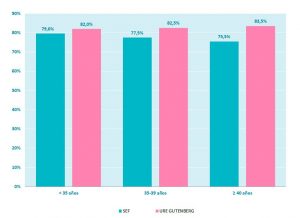
The graph above presents a cumulative success rate for IVF with donor eggs that is much higher than the cumulative success rate using own eggs. In addition, there is barely any difference in success rates between age groups. At URE Centro Gutenberg we have a success rate of 82% in patients under the age of 35, 82.5% in women between the ages of 35 and 39, and 83.5% in women 40 and over.
Single Embryo Transfer (SET)
For several years now the general tendency in assisted reproduction clinics is the transfer of a single embryo. This is called the “Single Embryo Transfer”, or SET. This tendency is becoming even more commonplace as its purpose is to reduce the number of multiple pregnancies, as these types of gestations pose serious risks to both mom and babies.
At our fertility clinic in Spain we are also doing our part to reduce the number of twin pregnancies. These accounted for 39% of gestations in 2008 and only 6% in 2018. This means that we increased the number of SET by 65% over the last decade.
Check out all clinical results from URE Centro Gutenberg in 2018
The information we’ve presented to you here is only a summary of our clinical results. If you want to take a look at all the graphs one by one, let us know and we will be happy to send them to you!
Do you have questions about this topic? Would you like to make an appointment with a fertility specialist to discuss your particular case? Contact us! We’ll be happy to help you clear up any doubts you may have along the journey to motherhood.

